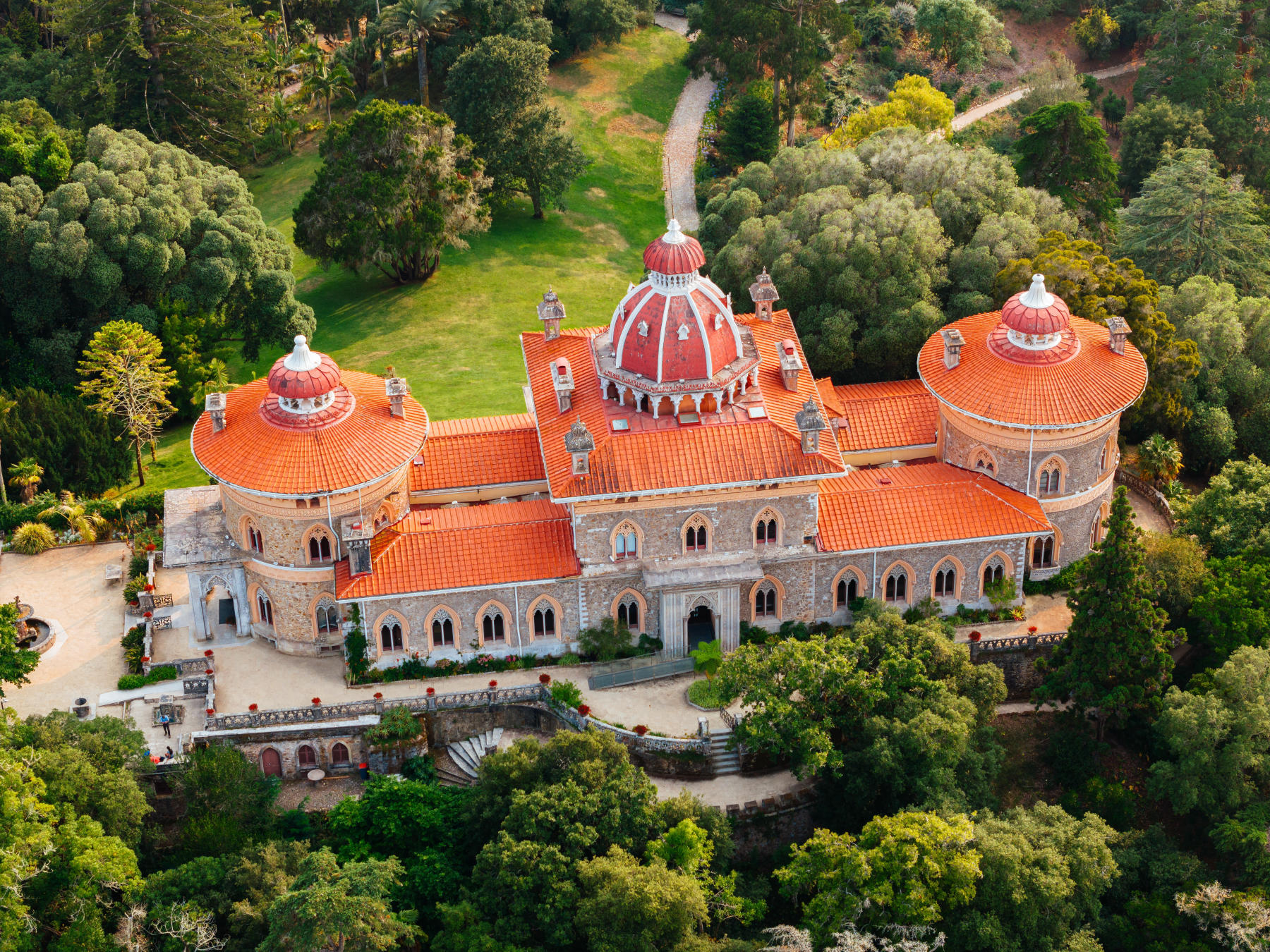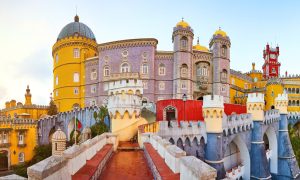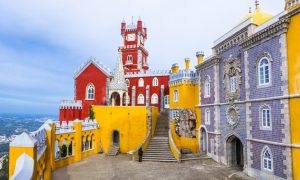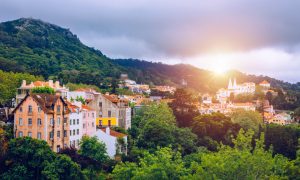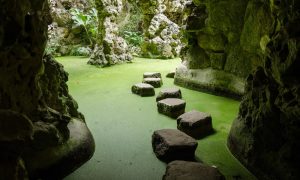Tucked away in the lush hills of the Sintra-Cascais Natural Park, Monserrate Palace stands as one of Portugal’s most captivating architectural gems. While Pena Palace often steals the spotlight, Monserrate offers a quieter, more intimate experience that feels like stepping into a forgotten paradise. With its exotic blend of architectural styles and lush botanical gardens, this palace and its surrounding landscape provide a serene escape from the more crowded attractions of Sintra.
Whether you’re a history buff, nature lover, or simply seeking a peaceful retreat, Monserrate Palace and Gardens will capture your imagination.
The History of Monserrate Palace
Monserrate has a long and storied past, beginning in the 16th century when a small chapel dedicated to Our Lady of Monserrate stood on the estate. Over time, it became a favorite spot for nobility, with the surrounding lands taking on significance for the wealthy families who sought to develop it into a true haven.
The story of Monserrate as we know it today, however, began in the 19th century when the English merchant and art collector Sir Francis Cook leased the land. In 1856, he began constructing the palace you see today, a stunning fusion of Gothic, Moorish, and Indian architectural styles, reflecting his cosmopolitan tastes and extensive travels. The exotic influences in the palace’s design stand as a testament to the spirit of Romanticism that swept through Europe at the time, with Monserrate Palace acting as a symbol of imagination and artistic freedom.
The surrounding gardens, designed in harmony with the palace, were transformed into a veritable botanical wonderland, with species from around the globe. Sir Francis Cook and his descendants took great care to nurture the grounds, curating plants from as far as Mexico, Japan, and Australia, and allowing them to flourish in microclimates that mimicked their natural habitats.
Monserrate has been open to the public since the 20th century and has become a UNESCO World Heritage site, recognized for its architectural splendor and unique botanical gardens.
Architectural Highlights
Monserrate Palace is an architectural marvel that feels almost otherworldly. Here are some of the palace’s most impressive features:
- Fusion of architectural styles: The palace combines Gothic revival elements with Moorish arches and Indian influences, creating a unique aesthetic that feels both romantic and exotic. The intricately carved stonework and detailed decorative motifs are unlike anything else in Sintra.
- Grand Central Dome: One of the most striking features is the central dome, which floods the palace’s interior with natural light, creating a bright and airy atmosphere. The play of light and shadow adds to the dreamlike quality of the space, further enhanced by the intricate latticework and colorful stained glass.
- Ornate Interiors: Inside the palace, you’ll find lavish rooms with magnificent tile work, elegant columns, and Moorish-inspired ceilings. The rooms were once filled with fine art and antiques, reflecting the wealth and artistic tastes of Sir Francis Cook. Although much of the original furnishings have been removed, the palace’s grand halls still exude opulence.
- Staircases and Arches: The stunning Gothic arches that frame each room, coupled with the delicate stone staircases, make Monserrate a photographer’s dream. Every corner of the palace offers a unique angle to capture its beauty, whether it’s the shadowed corridors or the ornate ceilings.
The Gardens: A Botanical Paradise
The gardens at Monserrate are just as impressive as the palace itself, stretching over 33 hectares of carefully curated plant life from around the world. Walking through the grounds feels like a journey across continents, where you’ll encounter lush tropical groves, delicate ferns, and towering cacti.
Here are a few highlights of the garden:
- Mexican Garden: As you wander through the estate, you’ll come across the Mexican Garden, filled with towering agaves, yuccas, and cacti. These plants thrive in the dry, sunlit sections of the garden and stand in stark contrast to the surrounding greenery, adding to the exotic charm of the estate.
- Rose Garden: The Rose Garden, blooming with colorful varieties of roses, is another beautiful section of the estate. It’s a peaceful spot, perfect for a quiet moment of reflection or simply soaking in the floral beauty.
- Waterfalls and Streams: Monserrate’s gardens feature hidden waterfalls and small streams, which weave through the dense foliage. The gentle sounds of flowing water enhance the tranquil atmosphere, making it an ideal place for leisurely strolls.
- Chapel Ruins: As you explore the grounds, you’ll also find the ruins of the original 16th-century chapel, which have been left partially overgrown by vegetation. These ruins add a layer of mystery to the garden, blending history with nature in a poetic way.
Best Time to Visit Monserrate Palace and Gardens
To make the most of your visit to Monserrate, timing is key. While the palace and gardens are open year-round, certain times of the day and year can offer a more rewarding experience:
- Arrive early: Like most popular destinations in Sintra, Monserrate can get busier later in the day. Arriving early, just as the palace opens, allows you to enjoy the tranquility of the gardens and the serenity of the palace’s interiors without large crowds. The morning light also adds a special glow to the lush greenery and the palace’s stonework.
- Spring and early summer: For garden enthusiasts, visiting during spring (March-May) or early summer (June-July) is ideal, when the gardens are in full bloom. You’ll witness the vibrant flowers in all their glory, particularly in the rose garden and exotic plant areas.
- Autumn: Autumn (September-November) is another beautiful time to visit, when the trees in the gardens change color, creating a warm, golden atmosphere that enhances the fairy-tale ambiance of the estate.
Insider Tips for Visiting Monserrate Palace and Gardens
- Combine with other sites: While Monserrate can be a stand-alone destination, it’s also possible to combine it with other nearby Sintra sites, such as Quinta da Regaleira or the Sintra National Palace. Plan to spend at least half a day here, particularly if you want to explore the gardens in detail.
- Wear comfortable shoes: The gardens are expansive, and there are plenty of pathways to explore, so be sure to wear comfortable shoes. The grounds can be uneven in places, especially around the chapel ruins and waterfall areas.
- Bring a picnic: Monserrate’s grounds are perfect for a leisurely picnic. Bring some snacks or a packed lunch and find a quiet spot in the gardens to enjoy the scenery.
Why Monserrate Is a Must-Visit in Sintra
While Pena Palace may be the crown jewel of Sintra, Monserrate Palace and Gardens offers a quieter, more contemplative experience that is equally enchanting. Its unique blend of architectural styles, serene atmosphere, and lush botanical gardens make it a must-see for anyone looking to experience the rich history and natural beauty of Sintra in a more intimate way.
Monserrate is a place where time slows down, allowing you to immerse yourself in its otherworldly charm. Whether you’re wandering through the exotic gardens or admiring the palace’s intricate details, Monserrate is a peaceful escape into a world of artistry, nature, and history.

